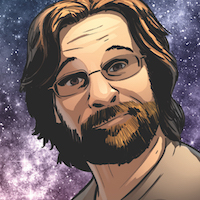From beyond the stars.
In our recent Racial Slurs of the Millennium Federation we mentioned that the friendly Shulentin are sometimes called “Thulhus” in reference to Cthulhu, the tentacled horror from beyond the stars created by H.P. Lovecraft. Garth has stated that the Shulentin’s design was based upon the popular imagery of Cthulhu, only without the wings and infinitely more friendly (though we’re still not sure if all those Cute-thulhu dolls count). I am a big fan of Lovecraft’s work, though I enjoy his less-known, not-horror stories the most.
Most people who know H.P. Lovecraft associate him with his horror creatures, and for good reason. They’re amazing. Cthulhu. Yog-Sothoth. Nyarlathotep. Azathoth. Shub-Niggurath. Their horror comes not from their tendency to stalk you from the shadows, but from their very nature. Incomprehensible beings from beyond sanity whose very existence is too much for our limited brains to handle. That the nature of reality is so unknowable that to gaze upon its naked mechanics, and the forces behind it, is to abandon reason. It’s good stuff. “The Haunter of the Dark” scared me so completely that I literally jumped out of my seat in the middle of a brightly lit afternoon. Ask me about that the next time you see me at a convention.
Lovecraft wasn’t all horror, though. There are three stories in particular that have their roots in wonder and adventure: The Dream Quest of Unknown Kadath, The Silver Key, and Through the Gates of the Silver Key. I’ve only just begun re-reading the first of these stories, which is why it’s on my mind today, so I may be off on some of the details, but Lovecraft’s “Dream Cycle” certainly has horror elements; it’s a story about a man who glimpses a beautiful city in his dreams, and through lucid dreaming he sets off on a quest through the Dreamlands to find it. The Dreamlands are another dimension that are accessible only to experienced dreamers, where villages and mystics and forbidden dangers lurk. It’s very high fantasy at its heart, and is a Lovecraftian adventure worth reading.
It does, however, rail against science and logic as tools that are destroying the mystical perception of artists and dreamers. Years ago I may have agreed with him, but my love of astronomy and the grand vistas of reality it has revealed has only strengthened my imagination. Perhaps Lovecraft would have benefited from learning about cities of stars (globular clusters) or immense clouds where the stars themselves are born (nebulae). Then again, we were only just discovering other galaxies in Lovecraft’s time, so that information probably wasn’t available to him.
The Dream Cycle is still a fantastic adventure that’s quite enjoyable and I recommend it if you’re looking for something different from a famous horror author.
